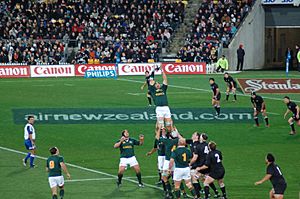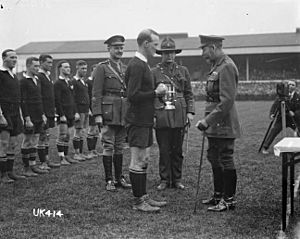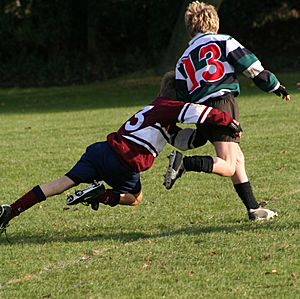Rugby union facts for kids

South African Victor Matfield takes a line-out against New Zealand in 2006.
|
|
| Highest governing body | World Rugby |
|---|---|
| Nicknames |
|
| First played | 19th century, England, United Kingdom |
| Registered players | 8,400,000 |
| Characteristics | |
| Contact | Full |
| Team members | 15 (with up to 8 substitutes) |
| Mixed-sex | Separate competitions |
| Type |
|
| Equipment |
|
| Venue | Rugby field |
| Presence | |
| Country or region | Worldwide (most popular in certain European and Commonwealth countries) |
| Olympic | Part of the Summer Olympic programme in 1900, 1908, 1920 and 1924 Rugby sevens included in 2016 and 2020 |
Rugby union is a fun ball sport played by two teams. Each team has 15 players. The ball is shaped like an oval. The game is played on a rectangular field. This field is about 100 meters long and 70 meters wide. At each end of the field, there are two H-shaped goal-posts.
A rugby game lasts for 80 minutes. It is split into two halves of 40 minutes each.
Contents
The History of Rugby Union
How Rugby Began
Long ago, people played games similar to football. The Romans played a game called harpastum. Players tried to throw a big ball into a net. In medieval Ireland, people played cad with an inflated bladder. The Welsh played cnapan with a wooden ball.
The game of "football" was popular at Rugby School in England by the 1800s. By the 1830s, players could run with the ball. But they could also be "hacked" (kicked in the shins). They could also be "collared" (grabbed by the neck).
In 1845, Rugby School wrote down its rules for the game. This was a big step. Later, in 1848, the Cambridge Rules were made. These rules helped make the game more organized.
The Big Split: Rugby vs. Football
In 1863, The Football Association (FA) was formed. They wanted to create one set of rules for football. Their new rules said players could not run with the ball. They also banned hacking.
Some clubs, like the Blackheath Club, did not like these new rules. They preferred the "Rugby Rules." These clubs left the FA. In 1871, they formed the Rugby Football Union. Their game became known as "rugby football." The FA's game became "association football" (what we call soccer today).
Later, in 1895, there was another big split in rugby. Many clubs in Northern England left the RFU. This was because players wanted to be paid for time they missed from work. The RFU wanted the sport to stay amateur. This split created a new type of rugby called "rugby league." To tell the two apart, the RFU's game became known as "rugby union."
Early International Matches
The very first international rugby match was played in 1871. It was between Scotland and England in Edinburgh. Scotland won that game. By 1881, Ireland and Wales also had national teams. In 1883, the first international competition began. It was called the Home Nations Championship.
Also in 1883, the first rugby sevens tournament was held. This faster version of rugby is still played every year.
In the early days, teams from different continents rarely played each other. Travel was very slow. But in 1888, a team from the British Isles toured Australia and New Zealand. Later, a New Zealand team toured Europe. These tours helped rugby grow worldwide.
Between 1905 and 1908, teams from New Zealand, South Africa, and Australia toured Europe. They showed new ways of playing. They were much more successful than people expected.
In 1905, the New Zealand team performed a traditional Maori dance called a haka before their matches. This led to national anthems being sung before sports events. France also played its first international match in 1905.
Rugby union was part of the Olympic Games four times in the early 1900s. During World War I and II, most international games stopped. But some local and army team games continued.
In 1973, the first official international rugby sevens tournament took place. It was held in Scotland.
World Cup and Professional Rugby
The first Rugby World Cup was held in 1987. It took place in Australia and New Zealand. New Zealand won the first cup. The first World Cup Sevens tournament was in 1993. Rugby Sevens was added to the Commonwealth Games in 1998. It also became an Olympic sport in 2016. Both men's and women's Sevens teams played in the 2020 Olympics.
Before 1995, rugby union was an amateur sport. This meant players were not paid. But in August 1995, the sport became "open." This meant players could now be paid. After this, big club competitions started. These included the Heineken Cup in the Northern Hemisphere and Super Rugby in the Southern Hemisphere.
In 1996, the Tri Nations tournament began. This yearly event included Australia, New Zealand, and South Africa. In 2012, Argentina joined the tournament. They had played very well in international games. Because four teams now played, the tournament was renamed The Rugby Championship.
How to Score Points
Scoring points is key to winning in rugby. Here are the main ways:
- Try: A try is worth 5 points. A player scores a try by putting the ball down in the "try area." This area is behind the goal-posts.
- Conversion: After a try, the team gets a chance for extra points. A player kicks the ball towards the goal-posts. If the ball goes between the two upright posts and over the cross-piece, the team gets 2 more points.
- Penalty Goal: If a team breaks the rules, the referee might give a penalty. The team can then try to kick the ball through the goal-posts. If it goes between the uprights and over the cross-piece, the team gets 3 points.
- Drop Goal: During the game, a player can try a "drop-goal." They drop the ball and kick it just as it bounces. If it goes through the goal-posts, the team gets 3 points.
Player Numbers and Positions
Each player on a rugby team has a special number and position. These positions are divided into Forwards and Backs.
Forwards
- 1: Loose head prop
- 2: Hooker
- 3: Tight head prop
- 4: Lock / Second row
- 5: Lock / Second row
- 6: Blind side flanker / blind-side wing-forward
- 7: Open side flanker / open-side wing-forward
- 8: Number 8
Backs
- 9: Scrum-half (or half-back)
- 10: Fly half/outside-half/outhalf (or first-five-eighth)
- 11: Left-wing
- 12: Inside centre (or second-five-eighth)
- 13: Outside centre
- 14: Right-wing
- 15: Fullback
Basic Rules of Rugby
The laws of Rugby Union might seem tricky at first. But they are easy to learn.
Passing and Tackling
- The most important rule is that you cannot pass the ball forward. The ball must always be passed sideways or backwards to a teammate.
- Only the player holding the ball can be tackled. A tackle is when an opponent brings the ball carrier to the ground. The tackler must use their hands to hold onto the player.
- When a player is tackled and on the ground, players from the other team can try to get the ball. They must stay standing. The tackled player tries to pass the ball backwards on the ground to a teammate. Their teammates will then move over them to protect the ball.
Game Officials
Four officials help make sure the rules are followed:
- The referee runs with the players. They control the whole game.
- The two touch-judges stand on the sidelines. They show when the ball goes out of bounds. They also signal if a goal kick is successful.
- The TMO, or 'television match official', helps the referee. They use video replays for tough decisions. Most professional games have a TMO.
Kicking in Rugby
Kicking is a very important skill in rugby. Usually, only the backs kick the ball. But sometimes, forwards will kick too. Players kick for different reasons. There are many ways to kick, such as a drop kick, grubber, up and under, punt, or a kick off a tee.
Images for kids
-
Sébastien Chabal (far left) in number eight position before entering the scrum
-
Japanese and Welsh rugby fans in Cardiff, Wales, September 2007
-
A giant rugby ball suspended from the Eiffel Tower to commemorate France's hosting of the 2007 World Cup
-
When codifying Australian rules football in 1859, Tom Wills drew inspiration from an early version of rugby he learnt at Rugby School.
See also
 In Spanish: Rugby union para niños
In Spanish: Rugby union para niños

















